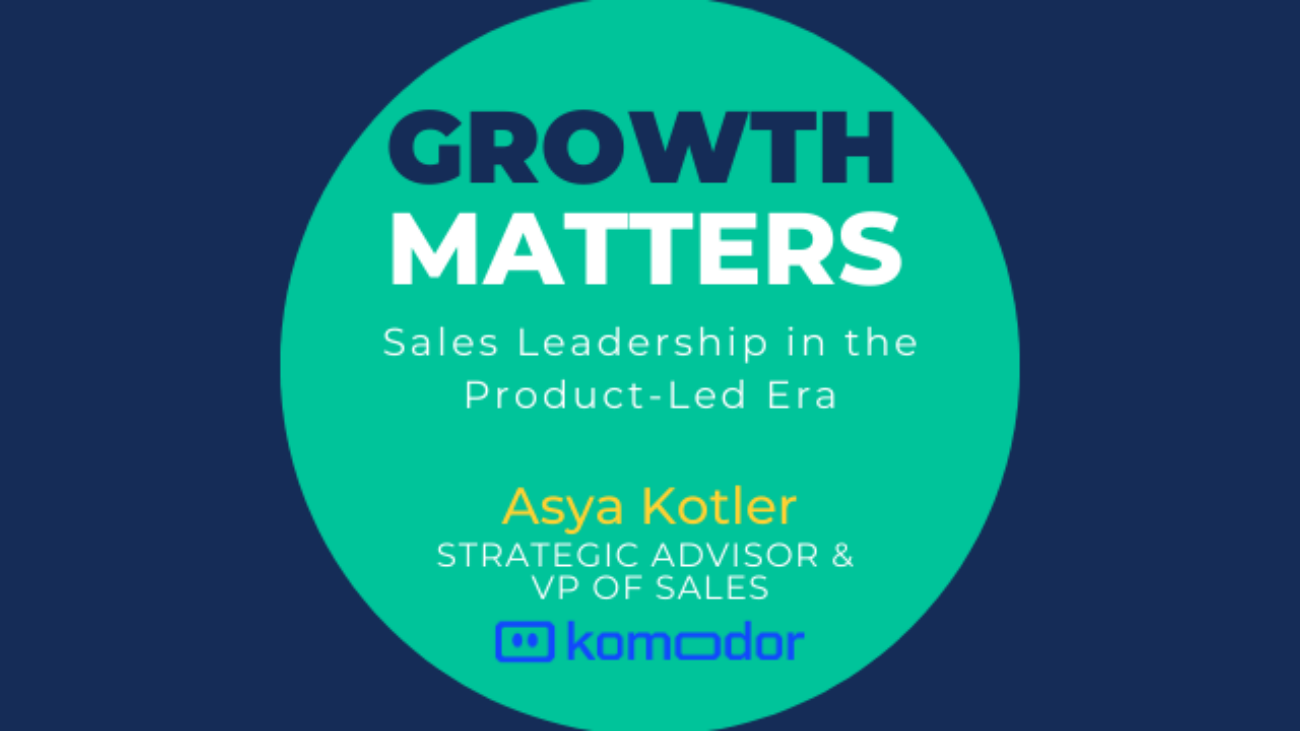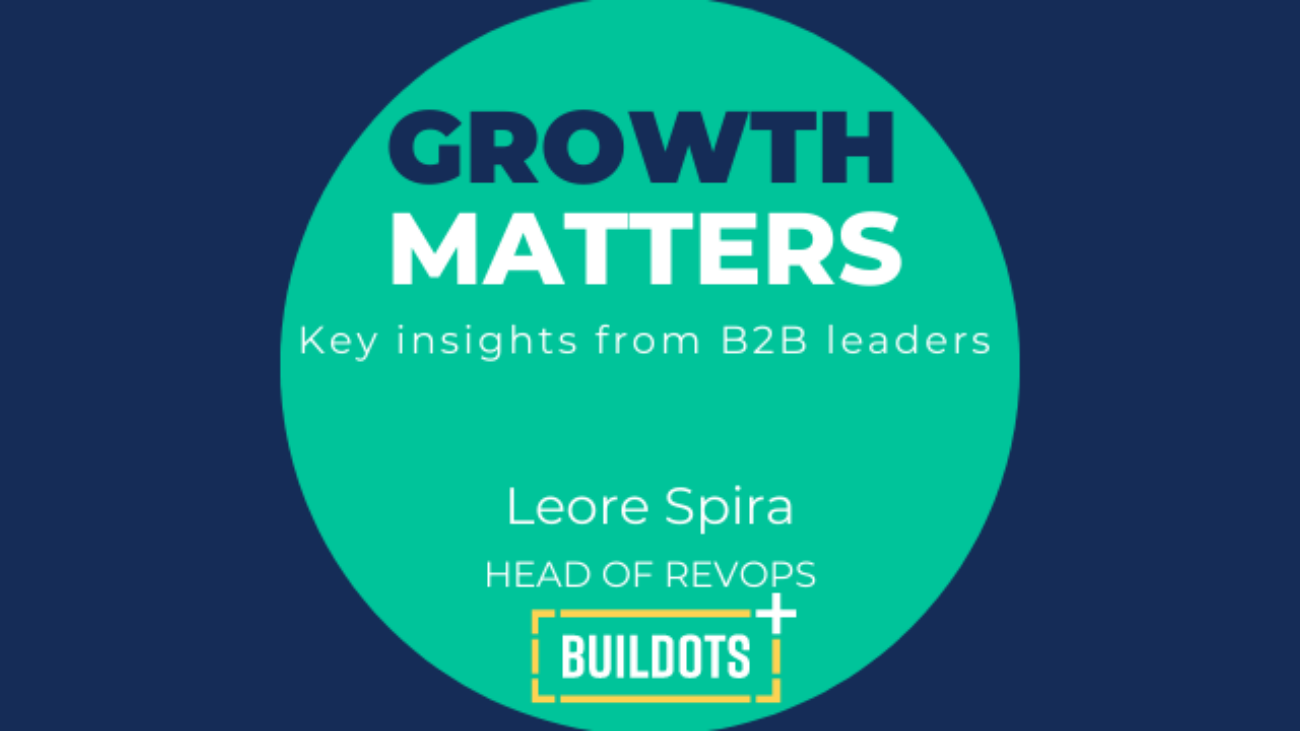The modern sales landscape is a labyrinth of Product-Led strategies, data-driven decisions, and interdepartmental synergies, making it a complex terrain to traverse. As our ‘Growth Matters’ series progresses, we aim to shed light on these complexities and chart a clear course through them.
For this expedition, we’ve enlisted the help of a veteran in this field who is adept at steering through these demanding dynamics. We’re pleased to introduce Asya Kotler, strategic advisor to early stage SaaS, B2B companies and VP of Sales at Komodor, whose broad experience and proficiency will enable us to explore these challenges in depth and equip us with the knowledge to navigate them proficiently. Welcome aboard, Asya!
Navigating the Changing Role of Sales in Companies Embracing PL Strategies
Successful sales leadership relies on three fundamental pillars: Strategy, Process, and People. And like a timeless classic, strong foundations are as relevant today as they were 10 years ago when I started my sales career.
However, a lot has changed, mainly the method in which businesses are achieving growth. Growth strategies have undergone a dramatic shift, requiring sales leaders to rethink their approach to building these pillars. And I will explain.
Before:
Strategy
Sales are orchestrating top-down processes such as product demonstrations and evaluations. Their efforts are concentrated on activities like defining the Ideal Customer Profile (ICP), executing sales-driven initiatives to boost customer acquisition (including cold calling, face-to-face engagements, and social selling), and ultimately closing deals.
Marketing aligning its efforts to support the sales team. This involves providing collateral, generating leads, and creating promotional materials to aid the sales process. And Product is responsible for fulfilling customer commitments (to help during or post sale) and balancing it with execution of the product roadmap.
Process
Sales are receiving a consistent flow of marketing qualified leads (MQLs) from Marketing and build a Process that will ensure the highest conversion from MQLs defined as sales qualified (SQLs) to paying customers.
Since the Sales team holds the sole ownership for driving revenue the Sales leader’s efforts will be invested into:
- Defining and adjusting the ICP and qualification metrics for MQLs and SQLs
- Building a strong partnership between sales and marketing to optimize the top of the funnel
- Optimizing the sales cycle to achieve higher conversion rates
- Setting up reporting based on key metrics to identify gaps in the sales process and assessing the efficiency of individual contributors on the team
People
Defining the hiring capacity, hiring and training new sellers in a sales-led company is a notorious overhead. The pitfall in this strategy when it comes to people is that the company’s growth is directly linked to each seller. Miss on the number of hires and you have a “floating” quota that is not directly covered, overhire and you have cost overhead which is never a pleasant conversation with the C-levels. This became even a greater challenge in 2022 when efficiency and cost of acquisition became top priority on any sales org as CFOs put a stop on the hiring rush we experienced in 2021.
While traditional sales-led approach continues to prevail in the market, and most of us are buyers of products which fully execute this strategy, many of the organizations, especially B2B SaaS companies, have been adopting Product Led strategy in various versions. From freemium to free trial, the adoption of the Product Led strategy brings about a complete transformation in the sales process, the criteria for talent acquisition (as well as the timing of it), and requires alignment with more departments across the organization.
Now:
Strategy
Product-led, user’s experience within the product takes precedence before any buyer interaction. It can vary from zero-touch models, directly leading to payment, to variations of low-touch, encompassing free trials transitioning to paid plans, and even high-touch scenarios with assisted onboarding leading to paid subscriptions.
Regardless of the specific approach, the sales team continues to play A HUGE ROLE in enabling revenue growth both through new customers but also through dedicated work with the CS team on existing customer expectations.
Marketing efforts in a product-led strategy revolve around increasing product awareness, driving user engagement, and enabling users to make informed decisions by providing educational content, tutorials, and resources.
Product efforts include qualified pipeline generation, building a zero-touch onboarding, driving adoption and stickiness through aha! moments and meaningful interactions between the user and the product.
A common misconception about PL strategy is that companies who embrace this model do not require sales to drive revenue. In fact, all the biggest Product led companies such as Atlassian, Miro, Canva, Inrecom (you name it) drive more than 70% of revenue through a product lead sales (PLS) strategy where product is the primary driver of user acquisition, generating high quality sales pipeline.
By applying this strategy, the sales leader can build a highly efficient, data driven sales process and make more cost-effective hiring decisions. Let’s dive into it a bit to understand how.
Process
For most of the companies undergoing a transformation from sales to product led, the most meaningful difference early in the process will be in the method of pipeline generation. Previously we mentioned how sales used to be the owner of a self-generated pipeline on one hand and worked with Marketing as a lead generation engine.
Is the sales leader still own the top of the funnel – yes.
Is the sales leader still responsible to verify the quality and quantity of the pipeline – yes.
But the sales leader is no longer the sole revenue driver and this changes things!
The prospects who sign into your platform are users, meaning end users, meaning they don’t pay or make organizational decisions (in most cases) which means the sales team is no longer looking at them as MQLs or hot-handedly approaches them.
This is where Product takes ownership in creating aha! moments and driving adoption.
The Product team has to make data-driven decisions through unique user behavior and cross-reference of multiple users from the same account, to qualify the value of the Account (PQA) prior to sales interaction.
From this point, the PQA is handed over to Marketing for nurturing and targeting. Marketing generates MQLs, based on the ICP sales defines, and this is where sales takes over.
The sales leader now invests most of their time on:
- Build strong partnership between sales and product to optimize PQA definitions and hand over processes, including high-touch vs. low-touch criteria.
- Build a strong partnership between sales and marketing to optimize the account based targeting, MQL definitions and multi-channel nurturing.
- Optimizing the sales cycle to achieve higher conversion rates between the stages in the sales process – Always true!
- Set reporting based on key metrics that will demonstrate the gaps in the sales process and the efficiency of individual contributors on the team – Always true!
By generating a data-driven pipeline, building user journeys that help the sales effectively demonstrate user adoption and product value to the buyer, the Product team takes shared ownership of revenue generation and that is the most important change in the sales motion when it comes to product led sales.
People
Since in PLS, the ownership over pipeline generation and qualification is shared between Product, Marketing and Sales, the required sales capacity for these activities decreases allowing the sales team to invest resources on strategic and focused subset of high intent accounts.
Additionally, you will need less XDRs to generate and qualify pipeline, and less AEs to manage more accounts. Most importantly, you can scale the business faster without worrying about capacity gaps. Each individual can do more with less, making your cost efficiency higher and your CFO happier.
Lastly, I wanted to lightly touch upon the pre-sales role. A lot can be said about the evaluation of this role over the years, but the most meaningful transformation when it comes to PLS is that users shouldn’t require support in installation or integration. Therefore, if in a traditional sales-led org you had pre-sales mostly responsible to lead the installation, nowadays, the solution engineers will help much earlier in the process. Oftentimes they will take ownership over in-app communication and help in bringing the buyer to a sales interaction through building a trusted relationship with the user. This is yet another great example for optimization opportunities PLS strategy carries.
One can’t discuss the vast advantages PL models bring to sales efficiency without understanding the motivation and some of the key challenges organizations will need to be aware of prior to committing to this transformation.
Redefining Sales in Today’s Tough Market
Anyone in a sales position today will tell you this: selling became 10x harder. According to Ebsta, 2023 B2B Sales Benchmarks Report, the main leading indicator to hitting the quota, pipeline velocity, dropped in Q1 2022 by 47% (QoQ) and from there the numbers are only getting worse: sales win rate dropped by 15% and the sales cycle lengthened by 32%.
Whichever strategy you choose as your GTM, you need to make sure it is lightweight, efficient and highly adjustable.
Being a Product-Led company puts you is a strategic position to move faster and scale, however, to maximize those advantages you need to address the following challenges:
- Resolve conflict between growth and sales teams
For PLS to really work, sales, product, marketing, and customer success must form a unified revenue unit. The days of separate teams working individually towards a shared revenue target are over. The team needs Clarity and Structure.
There will be a lot of noise. There will be a lot of cooks in the kitchen. But it is the revenue leadership’s role (including Marketing, Sales, Product, and CS) to establish clear boundaries and handover processes. This will guide team members on when to interact with leads and when not to, preventing negative user experiences. For instance, we want to avoid bombarding users with three emails, LinkedIn messages, and phone calls from different people in our company just because we’re eager. On the other hand, we don’t want to miss out on a highly relevant account because we’re unsure who the user is.
Decisions regarding outreach and follow-up methods should be data-driven and strategic, not driven by excitement or eagerness. To achieve that, you will need to:
- Define your Ideal Customer Profile to identify the user, champion, and buyer.
- Define the marketing responsibilities for low-touch automation and the sales responsibilities for high-touch and personalized outreach activities.
- Use data and AI-solutions to help define PQA and MQL criteria
- Over communicate, establish a handover process, hold weekly syncs, and define touchpoints for reviewing and adjusting as needed.
Lastly, remember that PLS is a team sport, so ensure that all this data is clearly displayed on dashboards that the entire company can track and understand.
- Optimize sales team efficiency and ensure the ability to handle increased pipeline
PLS strategy allows sellers to focus on high-impact activities. This may sound trivial, but for most sellers, reducing volume or changing the “more activity equals better results” mindset is hard not only from a business but also from a psychological perspective.
Reaching real efficiency means you will have to let go of old habits and build towards the winning formula.
For an early stage company taking first steps towards PLS, I recommend starting from a manual approach. Define a set of rules, mark the relevant account, define threshold for sales follow up vs. Marketing nurture.
If the sales-touched volume decreases while outcome increases? You are on the right path.
Most certainly, it won’t happen on the first iteration, this is why a weekly review and optimization are key. Once you create a repeatable process, it’s time to introduce automation: be it via sales automation for outreach, accurate and actionable CRM dashboards, and leveraging AI-powered tools for scoring and prioritization. Chat automation can go a long way to activating the user and help the sales team understand when is the right time to prioritize this account.
- Deal with complex enterprise sale that origin from self-serve
An average Enterprise process involves ~10 decision makers. Think about your seller trying to find all of them, connect, create personal relationships and all that, when the person actually using the product is way below in the food chain – making them almost a silent partner instead of the champion we need.
This is a huge overhead and scaling your pipeline in this manner can lead to poor performance and seller burnout.
If your company’s strategy is to sell to Enterprises through a PLS model – you better equipped Sales and Marketing with an ABM plan.
Complementary to the user activation through the product experience, use ABM to multi-channel and actively push more users, with a higher rank in the company to join the account.
The marketing team will create highly personalized content and advertising to target individuals that were identified as potential champions. Distributing the effort can be done in the following way: product focus on users, marketing focus on champions, sales focus on buyers.
In any ENT deal, regardless of the user experience in the platform, you will be required to frame the pain, quantify it and build a business case that supports strong ROI. Meaning, even the most effective PLS motion will not replace a well curated plan aligned with the prospect needs and goals.
Leveraging Product-Led Growth for ARR Success
Lastly, it is important to acknowledge that implementing a Product-Led approach is not a one-size-fits-all solution for every company, at every stage, or with any product or buyer. However, in today’s buyer landscape, it is crucial to harness the power of your users as a significant asset to achieve ARR goals, both from new customer acquisitions and existing partnerships, while simultaneously reducing reliance on expanding headcount across all revenue teams.








